
YEARS AGO IN FURNITURE WORLD 1939-1945
Anniversary Issue - World War II
by Russell Bienenstock
1939 marked a turning point for the furniture industry. It had been a long, depressing ten years since the stock market crash of 1929. The collapse of the economy resulted in high unemployment and precipitated a psychological change among Americans who became cautious consumers of durable goods such as furniture.
The May 11th, 1939 issue of Furniture World summarized a study by accounting firm Seidman & Seidman, reporting a “decline (in furniture manufacturing) for the year 1938 as a whole in spite of a sharp recovery in production, employment and payrolls during the last of the year. The 1938 slump hit the bedroom and dining room manufacturers hardest, according to the survey, which shows a loss of 28 per cent for the year, whereas the upholstery manufacturers came out best with a decrease of 20.5. Furniture prices declined only about five per cent in 1938. This was thought to be a good indicator, since other divisions of American industry suffered greater declines.”
Conditions were challenging in 1938, but as 1939 progressed, the general business mood became more upbeat. This, in spite of widespread worries about war troubles in Europe, scattered materials shortages, and growing taxation to support a build-up in military spending as well as new social programs.
Having been through so much Depression-era pain, furniture manufacturers were still worried. In the summer of 1939, a Furniture World editorial piece reflected this angst. Higher manufacturing costs, value-conscious consumers, and resistance at retail to price increases were squeezing margins. The July 6th, 1939 issue pointed out, “The growing tax load and its effect on the price of furniture is brought out vividly in an analysis recently completed by the Southern Furniture Manufacturers’ Association. In some cases taxes in the last two years have more than doubled.”
In the June 22nd, 1939 issue, with talk of the European war in the general press escalating, and industry people speculating about the effect of increased economic activity due to the possibility of the US being drawn into conflict, author Henry H. Heimann, wrote, “If any American business men hold a belief that a European war might help business, they are seriously mistaken. War hurts business. The world wide business depression since 1929 should be sufficient evidence of this for the majority of troubles we have had, resulted from the maladjustments brought on by the World War I.” As we shall see, Mr. Heimann, was both right and wrong in his assertion with regard to the demand for furniture. It all depends on the time frame looked at.
In fact, even without increases in military spending, many of the pieces had been put in place to support a full recovery. After passing legislation to stabilize and build confidence in financial institutions, the administration of Franklin Delano Roosevelt pushed through “second” New Deal programs that sought to promote consumer spending. These included the Works Progress Administration (WPA), the Social Security program and the National Labor Relations Act of 1935, also known as the Wagner Act. The WPA was an aggressive federally financed jobs program (1935-1943) consisting mostly of public works projects. It functioned to bring unemployed workers into the job market. The Wagoner Act set the stage for the widespread unionization of American workers, higher wages and improved working conditions.
These programs were intended to increase spending on consumer goods by providing funds to assist ordinary workers at the bottom of the economic ladder.
There is some debate as to whether these programs alone would have ended the Great Depression. That is because the build-up to World War II dramatically increased the scale of government spending. At the same time, the demand for raw materials and military hardware also boosted sectors of the economy involved in the export of these materials.
At retail, discounts started producing business. The April 6th, 1939 issue of Furniture World reported on business done by major furniture retailers, at that time, primarily department stores. In New York, “Stearn Brothers stepped out with an offering of fine upholstered furniture at discounts of something less than 50 per cent. The stock was made up of 139 pieces comprising sofas, love seats and chairs.
Representative pieces were sofas priced at $110, chair and ottoman at $98 and love seat at $69.50. Macy was in the lists with a section-wide clearance that drew fairly well and with an offering of low-end maple bedroom groups which got considerable attention. The bedroom groups were three-piece suites priced at $31.95… the clearance merchandise was priced at discounts of 20 to 40 per cent off usual prices. Bloomingdale was moderately successful with a promotion in maple bedroom suites priced at $79.50 for three pieces.”
The April 27th, 1939 issue reported further on this trend noting, “Aggressive promotional efforts have brought results that have helped many stores to better their figures for the corresponding period in 1938. The showing is not a source of much satisfaction to the majority of retail executives because of the marked trade dip in our area last year. Bearish elements such as the continuous war scare headlines in the daily press, the reality of our load of taxation from all directions, labor unrest, the coal strike, are generally viewed as the likeliest culprits by business.”
MARKETING ADRENALIN & SWEDISH MODERN
As spring 1939 turned to summer, the editorial content of Furniture World largely switched focus to more positive developments in furniture style, manufacturing and marketing, and away from talk of war and hard times. It was as if all of a sudden the industry had been energized with a dose of sales and marketing adrenalin. The prospect of improved business gave manufacturers license to develop new furniture products. It also spurred furniture retailers to create more innovative displays and marketing programs. A June issue of Furniture World documented this by noting, “Last year a new design trend made its debut at the markets and became the most influential movement in the furniture world. It was called Swedish Modern. Today, the same movement has grown and developed and changed and permeated other types of design. The simplicity of line, the lightness and grace of Swedish Modern caught the imagination of designers, manufacturers and decorators. The consuming public thought well of it as well. Now it is a part of American design.“
The enthusiasm for new modern design was high at a symposium held in 1939. In Furniture World’s June 15th issue, the best and brightest gave their predictions on the future of furniture design. Leo Jiranek, one of the most prominent and prolific furniture designers (and a member of the American Furniture Hall of Fame) said, “Furniture of the future will be created and manufactured for the masses and will be designed so that it will lend itself readily for mass production. While modern design will be far in the lead in mass production furniture, period styles will by no means be eliminated. Nevertheless, period styles will be very much simplified, devoid of elaborate carvings and ornamentation. They will be scaled and proportioned to meet contemporary space saving requirements….” In this commentary he also forecast the development and use of “rubber” cushioning materials that, he said, would largely replace upholstery springs, and predicted a large increase in the use of metal elements in furniture design.
In this same issue, John Gerald, B. Altman & Co’s decorating head, forecast that, “Decoration will not be weird, nor carried to excess, in the future. On the contrary, there will be few Louis XVI bathrooms in the houses of tomorrow. America is coming of age aesthetically. Tomorrow’s decoration will be based in the selection of furniture that suits us best.”
After the 1939 World’s Fair, a higher proportion of ads in Furniture World featured modern designs. And toward the end of the year, ads featuring “Early American” furniture started to appear.
WAR IN EUROPE AND ASIA
By September 1939, Britain and France had gone to war with Germany. Japan had already set up an administrative government in China. As the war increased in intensity, The US was still officially neutral, but continued to send more arms and raw materials to the allies.
In the September 21st 1939 edition, an editorial piece written by the National Association of Manufacturers came out strongly against engagement in Europe and encouraged concentration on domestic policies saying, “Europe’s problems do affect us, but our domestic problems still must come first.” And, “In a world distraught by force, the best way to preserve representative democracy is to practice it.”
War worries in the business community persisted as a threat to the ongoing economic recovery, but late in 1939 when N.I. Bienenstock editor, Ernestine Adams, Associate Editor, Frances Yost, Retail Editor and Bert Wyman, Advertising Manager were listed on Furniture World’s masthead, it was the opportunities that got the most column inches.
MILITARY SPENDING JUMP-STARTS THE ECONOMY
In the fall of 1939, military spending continued to increase as the US government initiated the first peacetime draft. Also formed at this time was the Office of Production Management (OPM) that would come to direct the bulk of economic activity in support of the war over the next five years.
In October 1939, Furniture World published a special issue, “The Furniture Industry of the Southeast”, that contained histories of the major southern furniture manufacturers. By that time the Southeast region had become responsible for the manufacture of 25 per cent of the wooden household furniture. In dollar volume, this part of the country produced 43 per cent of the bedroom and dining furniture and 11 per cent of the living room and library furniture. More than 75 per cent of this amount was produced in North Carolina and Virginia.
Toward the end of 1939, the Southern Furniture Manufacturer’s Association (Note to the reader - SFMA joined the National Home Furnishings Association [NHFA] in 1984 creating the American Furniture Manufacturer’s Association [AFMA], since 2004 known as the American Home Furnishing Alliance [AHFA]) said that raw materials costs had jumped 11-15% in the preceding three months (October 26th, 1936 issue). In spite of this, furniture sales had increased and in the November 16th, 1939 issue Furniture World predicted, “from all indications, Christmas sales this year will top 1938 and probably 1937. Everybody seems to feel more cheerful about this economic condition.”
By October 10th, 1940, with the march toward war pumping money into the economy, Furniture World reported that business was “good and there is every indication that the remainder of the year will show a growing volume.”
In that same issue Paul W. Casey the head of the Southern Furniture Exposition Building (now the Main Wing of the IHFC building), observed, “Indications that furniture retailers in this area are already feeling the stimulus in sales brought about by increased defense expenditures are apparent in the increased attendance at the Southern Furniture Exposition Building.” He also reported a slowdown of deliveries to retailers and that the conscription of 400,000 men who would need housing in Army camps was expected to boost demand for furniture.”
As added proof that the lean times had ended, new home construction in 310 leading American cities was said to have reached 10 times the 1934 total, the highest level in ten years. Attendance at the Fall Jamestown and Chicago markets was up.
HOUSING TAKES THE LEAD
An October 31st article in Furniture World titled, “1940 Housing Projects Take US by Storm” was upbeat in observing that, “Housing projects are sweeping through the country with whirlwind speed. They will figure more largely in the American scene, house more Americans, and contain more American furniture than ever before. Which means one thing to furniture manufacturers, dealers and retailers… Sales and more sales!”
This momentum carried through to the first part of 1941 for the furniture industry.
In a January 2nd, 1941 editorial, Herbert M. Rothschild, of the John Widdicomb Company spoke of advances on the credit side of the business. He noted that in late 1940, “the installment furniture trade showed signs of waking up at long last to the fact that the Mass market may be treated as though it had some dignity and self-respect. Advertising of the screech-owl type began to tone down and ‘Borax’ became a word to be shunned by all decent installment houses…. Carson Pirie Scott, Lord & Taylor and J.L. Hudson Co. did the outstanding merchandising of the year. Most stores were giving closer study to reduction in overhead, and the effort to make profit out of lower mark-up was most commendable.” Lower mark ups were due in part to bargain hunting consumers, and also increased prices charged by manufacturers, the result of higher raw material costs. Mr. Rothschild wrote that although many thousands of furniture manufacturers had gone out of business in the past five years, the remaining producers had more than made up the volume, resulting in a surplus of capacity.
The New York Furniture Exchange celebrated its 50th year in 1941, experiencing an all-time record number of 1,613 buyers registered for the opening day of the semi-annual market.
Furniture World’s ad pages increased steadily so that the January 16th, 1941 issue had 182 pages. And there was a noticeable increase in the level of creativity in ads that showed energy, bold headlines and creative copy not seen in previous years.
Attention increasingly turned to marketing strategies and consumer wants and needs. A January 23rd, 1941 article by John Smeallie, presented reasons why, “the home furnishings retail buyer of today is a far different woman from the one a decade ago.
Now that this country is back to normal, or even better, this fact must be seriously considered by all retail selling factories. The consumer has reached a very much higher standard of knowledge in all branches of styling, color, harmony, intrinsic values and merchandise generally.” He gave the following advice to retail salespeople. “A salesman must first understand a woman’s problem thoroughly himself before he can offer the counsel that he should… She wants the design and color to serve a purpose as well as please her vanity. She actually does not get excited about just how long the merchandise will wear or just how much it is going to cost. She is anxious to accomplish a pleasing, comfortable and correct setting that friends of hers, even better posted than she, will definitely admire.”
The marketing direction taken by furniture retailers and manufacturers at this time, set the stage for greater consumer focus and a concentration on selling coordinated furniture groups that would stick with the industry through the end of the century.
A January 16th, 1941 issue featured an address titled, “What’s Ahead For The Retailer In America Now,” given at the opening of the Chicago furniture market by Neil Petree, President of Barker Brothers who said, “The trend towards coordinate buying and ensemble selling is the most important development in merchandising home furnishings that has come into this field in the past twenty years.”
Another of his observations, about unbelievable advertised retail pricing discounts would, as well, be repeated by observers for the next 60 years. He cited a study of home furnishings advertising that showed a “high percentage of it to be on special sales, with price appeal as the principal attraction, and with almost universal use of comparative prices, many of them so unbelievable that consumer confidence was adversely affected. He called attention to the small amount of “institutional and goodwill building copy” used in retail furniture store advertising.
1941 EVENTS OF INTEREST
•The first ads for Formica Tops ran in Furniture World.
•The Southern Furniture Market opened four new floors and 70,000 feet of additional exhibit space in what is now the Main Wing of IHFC.
•A January 30th, 1941 article about smoking being prohibited in Jamestown, New York, home of the big furniture market, wasn’t referring to cigarette smoke.
“Jamestown residents,” the article reported, “will be honored with a smokeless city hall, it was learned here. Many complaints were received by the city council and many to the effect that the smoke streams rising from the municipal headquarters beclouded the fair city, its products, and even its furniture factories. All this will be changed with the addition of a new stoker and a different brand of coal. So now anyone can tell the difference between limed oak and solid mahogany.”
•March 6th, 1941 issue: “Sunday Registrations At Boston Market Break All Attendance Records For Day” with over 200 buyers and dealers attending.
•Hearn Department stores, became the first New York Department store to grant a five-day, 40 hour work week to employees, in an agreement reached with Local 1250 of the Department Store Employees Union, C.I.O., under threat of a strike.
•March 27th, 1941 issue: High Point attendance jumped 20 per cent due to housing projects, defense spending and dealers coming to the show from a wider geographic area. Paul W. Casey, General Manager noted that, “consumers are beginning to buy against expected price increases.”
•October 16th, 1941 Furniture World reported that the minimum wage for wood and wood furniture industries was increased from 30 cents per hour to 40 cents.
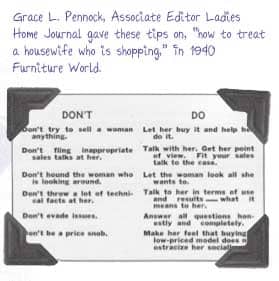
BOOMING RETAIL SALES
Late in January 1941, Furniture World reported that business had reached its highest levels in 11 years. The good news was accompanied by reports of new retail stores opening, and furniture factory expansions and modernizations. Warnings that wholesale prices would rise further did not dampen the enthusiasm. Neither did the continued threat of US involvement in the war in Europe (Canada had already committed troops).
Headlines in January 1941 issues read, “Furniture Goes Rapidly At Gimbel’s, Sloanes’ Mid-Winter Sale Jogs Along Well, Bedding Promotion at Altman’s Attracts Many, Muslin Group Hits Heights at Gimbel’s, Ashley Group Happily Promoted at Wanamakers, “Philadelphia Chair Co. Reports 100 Per Cent Increase, Retailing Active.”
Lord and Taylor made big marketing news with a window display that featured, “Cynthia – the mannequin- who is stopping New York traffic, who is being featured in furniture displays along Fifth Avenue, who is providing that highly attractive ‘Come Hither’ touch which interior exhibits have lacked ‘till now.... The point of the promotion, Lord & Taylor says, is ‘Colors To Live With Are Colors To Wear’ And the store has designed a series of rooms in traditional and modern styles to illustrate just that.”
Kroehler, then the largest furniture manufacturer, conducted a survey that “revealed that newlyweds are a $500,000,000 market which gives them a dominating position in furniture sales.” This was the beginning of another long term marketing trend for the furniture industry.
Still on the newlywed theme, Furniture World reported that a promotion campaign was launched that consisted of, “a series of radio programs, around which the furniture retailer may build a unique and thorough merchandising plan. The radio program is electrically transcribed for syndication and in itself offers a ‘natural’ tie-up for furniture retailers interested in selling the idea of refurnishing homes ‘little by little’ – as an appeal to newlyweds and those going into housekeeping to furnish their homes… for offering a more dignified method of payment in place of the trite and overdone ‘credit,’ ‘easy terms’ and ‘budget plan’ phrases.”
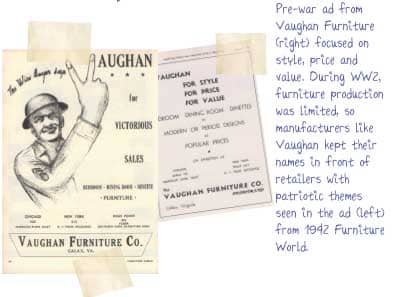
CHANGING RETAIL DISTRIBUTION CHANNELS
About this time the big, powerful department stores started to worry about the advance of other furniture retail channels, especially dedicated “neighborhood” furniture stores and low price, low service retailers. In a March 13th, 1941 issue, Charles W. Helser, Jr., Merchandise Manager Gimbel Bros. wrote, “Who are the retailers today? Let’s list them… There are furniture department stores. There is the large furniture store. There are the neighborhood furniture stores. There are the mail order houses. There are the decorating shops. And there are also what we term ‘curbstoners,’ who get it for you ‘wholesale.’ In all these seven types of retail, two types seem to be gaining ground. The mail order house that gives you no service, but tells you that you save money because of their large volume buying – no freight handling, salesmen’s commissions, sales rooms or warehouse rentals – no handling charges because you uncrate the furniture yourself. The other is the neighborhood furniture store where a high degree of specialized personal service is given and well selected stock is maintained.”
troubled times
By March 1941 Furniture World again reported metal and fabric shortages for furniture making, as more raw materials were diverted to companies involved in defense work. This threatened to idle bedding and upholstered furniture manufacturers. By the time the October 16th, 1941 issue was published, the situation had worsened, noted a feature article, “Word has been given out,” it said, “that after the first of the next year, no hardware can be supplied without priority ratings, and priority ratings are not granted for furniture.… Small ornaments, drawer handles, casters, locks and hinges made of metal are indispensable to the sale of furniture, and the trade associations declare that such hardware and the few tons of copper, zinc and steel to manufacture it are lacking. And therefore the OPM (a federal agency, Office of Production Management) has listed the City (of Jamestown, NY) in the first half dozen to be surveyed as potential victims of priorities unemployment…. The metals are urgently needed for defense, but the needs of civilians for work and wages are just as urgent.”
October 30th, 1941 Furniture World reported that the National Consumer-retailer Council, had formulated a plan to create “closer cooperation between consumers, retailers and manufacturers in the present emergency.” The emergency situation referred to, was the result of rising prices, raw materials shortages and delivery delays. The guidelines sought to discourage scarce advertising and panicky buying, educate consumers through proper labeling, and streamline and simplify merchandise lines to eliminate waste.
In November 1941, the news in Furniture World turned more directly to product and raw material prices. On November 20th, an article, “Enact Strict Price Control Law,” reported “The OPA is contemplating a price schedule to freeze current prices of wood furniture at current levels as part of a general price control bill.”
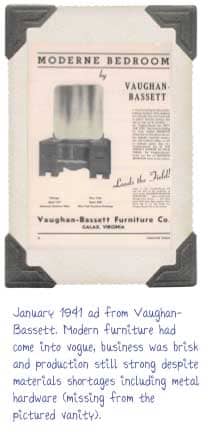
US ENTERS WAR
On December 7th, 1941, 360 Japanese warplanes attacked Pearl Harbor destroying the US military base there. Congress declared War on Japan and just four days later on Japan’s Axis partners, Germany and Italy as well.
For many months previous to this pivotal event, it had been obvious to Furniture World readers that a state of emergency was in effect. A military build up had been underway for many months, as the US prepared to enter the conflict. After Pearl Harbor, materials shortages, inflation worries and eventually labor shortages due to forced conscription became more acute.
In the first months of the war, furniture sales increased, due most probably to what Furniture World described as “hoarding” by retailers anticipating higher wholesale prices and additional taxes. It was reported in the November 27th, 1941 issue that some of the weakness in retail sales was being offset in the furniture manufacturing center of Jamestown, NY, by the first wave of large-scale government contracts to area manufacturers “to make furniture for the navy and other departments. Some of Jamestown’s factories, as has been the case with wood furniture companies all over the country, have been able to take over defense work, where their machines were suitable for the production of defense items other than furniture.” This trend accelerated as the government started to replace metals on defense production jobs with plywood due to metal shortages.
In a December 4th, 1941 article, Furniture World added, “Inflation hovers like a threatening storm cloud over the country as the industry and businesses struggle to adjust to wartime disruptions. As part of the government’s attempts to avert monetary inflation, production, prices, wages and all other factors of the economic scheme are being placed under curbs and checks. The limiting of installment credit is the curb creating the most difficulty for the consumer and retailer today.”
The situation for upholstery manufacturers was becoming dire, as their production methods were not suited for defense work. Because of this, the availability of metal parts such as springs, tacks and nails was severely restricted or totally cut off.
Still, on December 18th, 1941 Furniture World reported that, “In spite of air raid warnings and a gloomy outlook for civilian affairs, the general tone of trade is optimistic. While there was a small slump on Monday and Tuesday of last week, directly after the outbreak of hostilities was received, the decline was surprisingly small, contrary to the expectations of many merchants who were prepared for a sharp slump.”
Wooden furniture supplies and sales held up well compared to metal appliances and automobiles. The January 8th, 1941 issue voiced the sentiment that, “It is hoped that the money usually spent on automobiles, and consumer durable goods will be diverted to home furnishings lines, and thus hold sales levels up to somewhere near 1941 highs. Promotional emphasis in some cases will be shifted, with lower-priced furniture pushed forward, particularly in defense areas. Bedding and upholstery will be plugged, to replace sales of hard lines which are no longer obtainable. Some stores are planning to play up temporary merchandise or double-duty items, which can be moved easily after temporary living quarters are abandoned.”
Editorial features spoke of how the war might open up creative opportunities for furniture retailers. Paul W. Casey, General Manager of the Southern Furniture Market in High Point, advanced the opinion that, “such items as ranges, refrigerators, and other types of metal goods will be increasingly hard to get and the furniture dealer will look more to wooden household furniture to replace the volume lost to the scarcity of this type of goods.”
In each successive month, of 1942 advertising in Furniture World became more patriotic in tone (see examples). The war effort had the effect of re-allocating resources. A February 5th, 1942 column observed that, “war production has brought unusual prosperity to some cities, while others are experiencing wide unemployment due to closing of plants engaged in non-defense industries.”
From a merchandising standpoint, innovation continued. The trend was toward the use of color to coordinate rooms, or shops within stores. Furniture World advised, “Just as the setting up of model rooms originally marked an advance over selling from heterogeneous floor displays, so this new idea of ‘the shop’ marks a second advance over the model room. Shops throughout the metropolitan area have swung increasingly to ‘shops’ or ‘houses’, using accessories to sell furniture and vice versa, with color the most dominating note in sales promotions.”
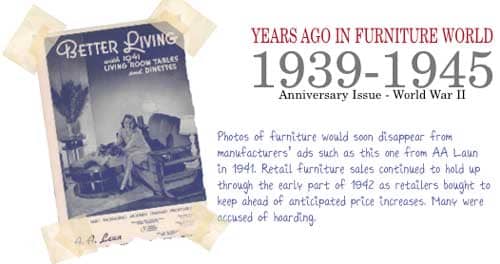
DELIVERY PROBLEMS & CONSERVATION EFFORTS
Modern design popularity continued during the war years as a primary trend, and although domestic woods and veneers remained plentiful, imported goods, metal parts and finishing materials became scarce. Another big problem for retailers resulted from rationing restrictions on the sale of tires for cars and delivery trucks. Furniture retailers found temporary solutions. The February 19th, 1942 issue explained, “Stores have pooled equipment, with all the units in the pool using the same vehicle so that tires of all will be commonly useful.” They also limited deliveries so that, “Only large articles are to be delivered, and only once a day so that full loads are assured.” In the ensuing months, gasoline would be rationed as well, and in April 1942, Furniture World noted, “Retail stores might actually go back to horse and carriage delivery on short hauls.”
Furniture World editorial coverage necessarily concentrated at this time on ideas for conservation, and the duty of the industry to support the war effort through conservation, plus “the payment of increased taxes, purchase of defense bonds and stamps, and contributions to the war charities.”
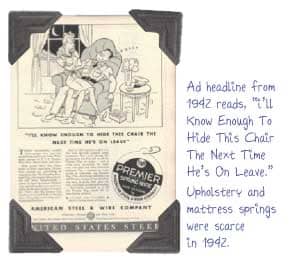
WAR & GOVERNMENT ROLE ESCALATES
As the ground war in Europe escalated, the furniture industry participated in the “First National Defense Home Furnishings Market,” that took place in May 1942 at the American Mart in Chicago. Displays dealt with, “war and defense projects, including housing, camp equipment, black-out material, and a score of other items made or makable in factories previously engaged in manufacturing only product which turn houses into homes.”
The good news reported in July 1942 was that dollar sales of furniture for the first half of 1942 were about even with the same period in 1941, though unit sales had marginally declined. The bad news was that inventory levels of many types of goods sold in furniture and department stores such as appliances and chrome dinette sets had been depleted. Floor coverings, and springs for mattresses and upholstered goods were just about gone.
Increasingly, the US government controlled both the personal and business lives of Americans. In the August 20th, 1942 issue, industry salesmen agreed at a meeting of the National Wholesale Furniture Salesman’s Association to petition the Office of Price Administration to increase their gas allocation to get “enough gas to drive at least 1,200 miles per month, which is but 50 per cent of our normal mileage, to reach places that are inaccessible or poorly serviced by trains or busses.”
Retailers started offering re-upholstering services. The October 1942 issue reported that, “the War Production board has issued Orders L-135 and L-49 prohibiting the use of iron and steel in upholstered furniture after November 1942.”
As the war progressed and more factories were engaged in defense activities, furniture items became scarce. Furniture World commented, “Although much of Grand Rapids furniture factories now are devoted to the all-important job of winning the war, manufacturers exhibiting in Grand Rapids are making definite plans for the day when they not only can convert their factories back to the production of furniture but utilize the lessons they have learned in war work in improving furniture making operations.”
A contemporary reader might assume that with less production to sell to retailers, advertising in Furniture World Magazine declined dramatically. Manufacturers, however, seemed to take a long-term view. As noted above, they were making plans for the day when their factories would be converted back to domestic furniture production. Furniture manufacturers engaged primarily in “war work” continued to advertise in Furniture World, but instead of touting their new groups or market introductions, they sought to keep their names in front of buyers in advance of “V-Day.”
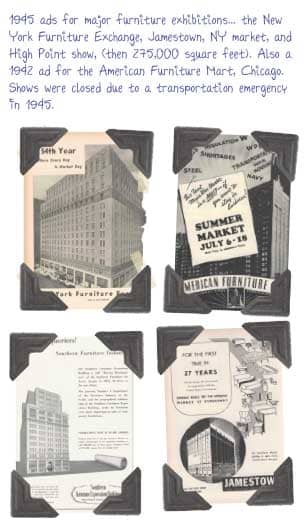
1943-1944 ADVERTISING THEMES
•Sanford Furniture Ad, December 23rd, 1943: “Sanford dealers are receiving less furniture but are using it to keep up morale in the war worker’s homes. They understand that we are doing everything possible to keep up furniture production and they want us to keep up war production first.”
•December 30th, 1943 Heywood Wakefield: “We invite realistic, practical furniture buyers and merchandisers to check Heywood-Wakefield as a potential postwar resource. It might do both of us some real good and it might make both of us some money too.”
•December 30th, 1943: “The Shortest Distance to a Bullseye in Furniture is Vaughan-Bassett Furniture Company.”
•Crawford Furniture January 6th, 1944: “This company being 80 years old, needs extensive remodeling of its physical assets to be of greater service to the war effort for the duration. The minute peace comes we will be in excellent position to solicit your business with a longer and finer line than ever.”
•The Mersman Bros. Corporation January 6th, 1944: “Here are four tables from the Mersman line for 1944… You are aware of the fact that civilian production has been curtailed, but we will continue to make shipments as we have in the past.”
•United Furniture Corp January 1944: “Frankly, we at United Furniture aren’t giving you, our customers, all the merchandise you need. We’re sorrier than you are about that. But we’re mighty proud of the reason why…”
•Hickory Chair Manufacturing Co, Ad January 6th, 1944: “Due to the fact that ninety per cent of our production is devoted to the manufacture of material for the armed forces, we will not have anything to exhibit. However, since market dates have been set and many buyers will make the long trip to the market, our space will be open and representatives of our company will be in attendance to discuss mutual problems with dealers. Two hundred of the 700 men at Hickory Chair are in the armed forces.”
•Red Lion Furniture Company January 6th, 1944 ad: “We look forward to 1944 – to the end of the war and strife and to the return of the American Way of Living.”
•Kroehler Furniture Ad (World’s Largest Furniture Manufacturer) January 13th, 1943: “Kroehler has not, and will not, compromise with quality. We will not compromise your future, your reputation. This may mean that until Victory there will be less Kroehler Furniture for you to sell…”
•Southern Furniture Exposition Building January 20th, 1944: “We have made all the necessary plans for immediate post-war reconversion to a furniture mart – and we are looking forward to one day soon, when we can again serve the Furniture Industry as we are serving our country today.”
•Ad sponsored by the Stanley Furniture Company February 3rd, 1944: “Keep Backing the Attack! – With War Bonds.”
Interestingly enough, even with the war accounting for about a third of gross domestic output, widespread rationing, shortages and personal loss, Americans were still seen by some as complacent. In a January 6th, 1944 editorial, Furniture designer and American Furniture Hall of Fame Member Leo Jiranek wrote, “The war has been an inconvenience to Americans at home, but we haven’t suffered as have the English, Russians, Italians, Germans and other nationalities. Perhaps if we had suffered more on the home front, we would not be so complacent… Furniture manufacturers have had to use their ingenuity to overcome the inconveniences of war, but as we have been in a seller’s market, this hasn’t been difficult to do. Buyers have taken almost anything, and as a result, furniture sales, manufacturing and merchandising efforts have become careless and static, in fact, instead of progressing steadily as it has in other years, the furniture industry has slipped backward since the war started.”
In retail news, a February 24th, 1944 editorial reported that a survey of retail store advertising budgets showed that an “overwhelming number of retail outlets queried have increased their use of Institutional Advertising, while a substantial majority, or 79.8 per cent, feel it will be to their advantage to use less promotional copy…” This, of course, made plenty of sense in the war time “sellers market.”
By March 1944, in response to some industry attempts by companies to get around price controls by creating multiple layers of distribution, an OPA ruling prohibited furniture manufacturers from “increasing their prices by establishing new jobbers who would buy from them, then resell to retailers or other jobbers at higher than the manufacturers’ ceilings.”
By the summer of 1944, the war news, from the US perspective had turned positive. In August 1944, Paris was liberated from the Germans. By October 26th, 1944 with the war in Europe having turned in favor of the allies, the coverage in Furniture World faced the challenges of meeting pent up demand for furniture once the War ended. Subjects such as the lack of distribution facilities, high taxes and price controls were discussed.
In January 1945, Soviet troops captured Warsaw; in February, Dresden was bombed by the Allies; all leading up to and V-E Day (Victory in Europe Day) in May, 1945.
Anticipating the war’s end and a return to business as usual, Furniture World published a special supplement, “Furniture Industry’s Part in World War II” in the April 19th, 1945 issue. It contained a message from the director of government procurement Cliffton E. Mack, thanking the furniture industry for its “100 per cent plus” cooperation. He reviewed some wartime statistics, noting that, “between January 1st, 1942 and June 1944, Procurement purchased approximately 443,438 desks, both victory and the conventional type, with a money value of over $11,500,000. During the same period we purchased approximately 165,202 file cases with an approximate value of $4,481, 007.”
Charles R. Sligh Jr., then President of the National Association of Furniture Manufacturers, wrote a review of wartime production listing many of the unusual items made by furniture factories in support of the wartime effort. “Among the more unusual items,” he said, “which would probably include at least 200 different articles are, gunner seats, airplane models, artificial feet and artificial ankle blocks, and radio antenna arms. Upholstering facilities are making such things as tents, army cots, ship fenders, bedding rolls, canvas dispatch and map cases, and collapsible boats for the navy. Of course the most spectacular are the large gliders and the fuselage and wings for large planes.”
Stuart Foote, the influential President of Imperial Furniture Company wrote in his article, the ‘Grand Rapids War Story,’ “When the long secret B-29 bombers dropped their devastating ‘eggs’ on Japan herself, the map case having the precious charts of the navigator and the other parts came from the furniture capital of America. The self sealing fuel tanks for this same super bomber were built in a famous Grand Rapids furniture plant.”
The section lauded the contributions of the furniture industries of “our allies,” Canada, Great Britain, China, and Latin America. Also discussed was the use of mahogany in the construction of PT boats and walnut in gun stocks.
Contributions of many furniture manufacturers to the war effort were listed along with photos of the products made. The list included many still familiar company names:
•Manufacturer Bassett Furniture Industries, Inc., “made more than a million and a half dollars worth of cargo truck bodies for the Army.”
•Crawford Furniture, Jamestown, NY made “dishwashing racks for Army use by the carload, and its war production has included cooks’ tables, ariel bomb crates and furniture for nurses’ dormitories, officers’ quarters, hospitals and war plants.”
•Drexel Furniture Company, Drexel, NC produced, “plywood parts for boats and planes, special tow targets, tent pins and practice shells.”
•Eclipse Sleep products Company’s subsidiary United Cabinet Bed Company, supplied, “artillery supplies, gun accessories, bore sights, mosquito and insect bars, head nets and mattresses and other sleeping equipment.
•The Englander Company made “such vital needs as mattresses, hospital beds, first aid litters, double deckers and triple deckers.
•Hickory Chair company supplied, “ammunition boxes for the Army, Air Force supplies, beds for the Navy and cushions for sub-chasers and PT boats.”
•Charles R. Sligh Company produced, “film racks and one-ton wood cargo trailer bodies. At present they are working on chemical bomb boxes, 50mm cartridge cases, rear gunners’ seats and floors, oxygen bottle racks for bombers and azimuth scales.”
•Stanley Furniture Company “was one of the largest producers of truck bodies and plywood panels for the government during the war years.”

POST-WAR
After Victory in Europe (V-E ) day, men and materials were transferred to the Pacific theater and shortages continued.
Throughout the war years, furniture factories had lost many of their skilled craftsmen. Clyne Crawford, President of Crawford Furniture, Jamestown, NY, provided some statistics. “Jamestown has 55% fewer men, in the furniture plants than they had at the time of Pearl Harbor” he wrote. “Only 11 per cent of the Pearl Harbor employment is 45 years or younger. Men up to 82 years old are counted in today’s figures. Many of the younger group are disabled or returned veterans.”
The bedding industry, according to the May 24th issue of Furniture World, forecast a serious shortage of innerspring mattresses and possible shortages of “tickings and filling materials which may even reduce the production of felt mattresses.”
A transportation emergency was declared by the War Committee On Conventions of the O.D.T., effectively shutting down the summer 1945 furniture markets. June 17th, 1945 Furniture World reported that “new orders booked by furniture plants in April 1945 were down 19 per cent. Backlogs of unfilled orders increased, and employment continued it’s downward trend.
By June, regulations restricting the manufacture of, “bedsprings, box springs, innerspring mattresses, studio couches and other types of bedding” were lifted by the War Production Board, but production remained negligible for many months.
In July, anticipating the end of the war, Furniture World news turned away from reports of materials shortages. Ads started to promote new products and reported on the many new laws passed to regulate the pricing, distribution and sale of goods in the post-war period.
On August 14th, 1945, just a few days after atomic bombs were dropped on the Japanese cities of Hiroshima and Nagasaki, the Japanese surrendered, ending a long and difficult period for the world, the US and the furniture industry.
Interest in selling Modern furniture picked up where it had left off in 1939. Catherine McCreery, wrote an article in the July 19th issue on “Functional Modern.” She asserted , “The war has done much to further interest in the trim, tailored lines of good Modern – they seem the ideal answer for the need for the compact living that wartime conditions demand.”
Louis S. Bing, Jr., of the Bing Co., Cleveland, OH predicted, “Better merchandising, better merchandise displays, better selling and higher degree of service keynote the (post war) change.” He asserted that the “independent aggressive home furnishing store, doing a job and living with its community, will retain its position in the growth of American communities.”
“During this war,” said Clyne Crawford of Crawford Furniture, “ a great forward surge has taken place in the discovery of new plastic glues which have made it possible for woodworkers to make PT boats, mosquito bombers, and other such fighting weapons… These same new methods and techniques will be applied to furniture after the war. Your furniture will have a built-in quality, not formerly attained and will be water resistant, alcohol-proof, cigarette burn-proof and precision fitted.”
Thomas E. Higgins of retailer Barker Bros. Town and Country, Los Angeles, CA predicted, “Color will be used on ceilings, in kitchens, bathrooms, in fact, everywhere. And, moreover, it means that color will also be used on the furniture wood itself.” He forecast the “use of more decorative store window displays as well as model rooms and backgrounds throughout furniture stores.”
Higgins’ predictions were realized in the post-war years, which are examined on the following pages in this 140th anniversary year issue.
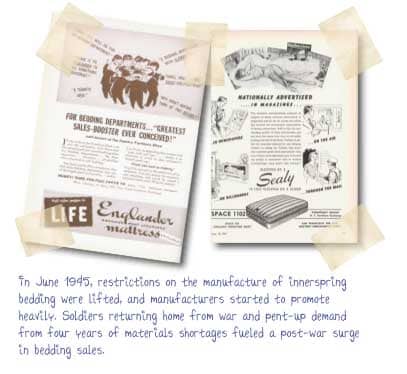
Excerpted From American Furniture Hall of Fame
Interview with Lawrence Schnadig -Founder, Schnadig Furniture-
“You Couldn’t Put Springs Into Upholstered Furniture Legally.”
“With the war came the restriction that you can’t put steel in
upholstered furniture, bedding or anything else. At least, it was limited so that the amount of steel necessary for a sofa bed was completely out. This started another point of my career.
“You couldn’t put springs in upholstered furniture legally. It was done. We didn’t do it and lots of other people didn’t do it, but some people did. There was a guy working for me and he developed the wooden spring, made out of hickory, and it was like a leaf spring in an automobile.... We were able to make upholstered furniture with wood springs. It certainly didn’t sit or feel like the real thing, but it was durable, so we made that. Nobody wanted it, but they bought it because the other wasn’t available.
“We couldn’t sell enough furniture made like that to use our factories. So we got into, at that point then, the goods used in the war effort. I mean like mess tables, bunk tables. We made teak floaters for mine sweepers and that character of goods, which kept our factories at least there and doing something and our work force employed. These things were bought in colossal quantities.”
Excerpted From American Furniture Hall of Fame Interview with Nathan (Nat) Ancell. Founder, Ethan Allen Furniture
“Those Were Terribly, Terribly Traumatic Days For Me.”
“War came. In 1941, we stopped making furniture... We had eight or ten sales people out in the field. They went into the Army....
“And I had to practically live two or three days a week in Washington, DC in order to try to get some War work with priority so that we could keep our factories open and manufacture something. So we manufactured - well most of the things Washington was buying were steel and metal. There was not very much wood. And we found some wood things that we could make. We made gun stocks. We made kitchen tables, quartermaster tables. As the War developed, we had a couple of horrible jobs. We made coffins to transport the dead soldiers back from Europe to the United States. Another job we got was wood crosses to go over the graves.
“Because our kids - our brothers and fathers and everybody - were over there getting shot and killed and bloody and legs off and arms off and all the horrible things that were happening in the War. And down in Washington, there were thousands of (expletives deleted), who were having parties. These five-percenters who were making millions of dollars giving contracts and promoting contracts to industry and getting paid off by the industry and paid off at the government end... And there was, in many cases revelry in Washington. And I remember one party I was invited to and I was there for about a half hour, and I couldn’t even stand looking at them - they were dancing... There was booze flowing... And all that revelry. And all that going on. And all that money being made. And all those pigs that were living off the blood of all these poor people who were getting shot... trying to protect these people. I want to tell you, those were terribly, terribly traumatic days for me. They were terribly traumatic. And I’ll never, never, never forget them.”
The Mattress Makes The Man!
January 6th, 1944 Furniture World
Why should you pay $39.75 for a mattress?
From a January 6th, 1944 Furniture World Article titled, “The Mattress Makes the Man.” “People ask me, Why should we pay $39.75 for a mattress?” I answer, “Well you can bed a horse for about $1.50 a month – that’s $18 a year – $36 for two years. Yet people have been buying mattresses for less than that – and expecting the mattress to last a lifetime! So, which is worth more – you or the horse?”
Philadelphia Retailers Accused of Giving Preference to War Refugees -Retailers Deny Assertions.
April 13th, 1939 Furniture World
“Employers, religious workers and social agencies denied rumors that Philadelphia stores were hiring Jewish refugees in preference to Americans. ‘Not more than 25 refugees have been hired by department stores in the last five years and in no instance has a Jewish refugee replaced a native American on the payrolls,’ heads of Philadelphia stores with payrolls of 15,000 persons said.”
Tips For Retailers
July 13th, 1939 Furniture World
How To Bring Prospects Into the Store
• Improving window displays. Merchandising windows carefully.
• Using the interior decoration appeal in windows and ads.
• Dramatizing our appeal with a “brand” name.
• Using a Trade-in Plan effectively.
• Free newspaper publicity to get “releases” into the paper.
• Model houses and apartments outside the store.
• Open House Exhibitions.
• Public and school-contests.
• Using the written Service Guarantee in windows and ads.
• Canvassing – cold, and by coupon.
• Using your trucks for advertising.
How to Make More and Bigger Sales.
• Sales Personnel training.
• Adapting interior decoration to your operation.
• Increasing the sale of RELATED ITEMS and accessories.
• Planning and furnishing of model rooms or groups.
• Floor display and arrangement.
• Price Tags with information for customers and salesman.
• Tie-up of display with advertising – merchandising “step ups.”
• Model Door Sheet and Prospect Cards.
• Using “brand name” to sell higher units.
• Effective display signs for windows and floors.
• Contests for salesmen and other employees.
• Successful follow-up of “walk-outs.”
• Using the Written Service Guarantee to make the sale.
• Extra ammunition for salesman to overcome price factor.
• Interior House promotions – displays for “impulse” buying.
• Eliminating old-fashioned “borax” methods and talk.